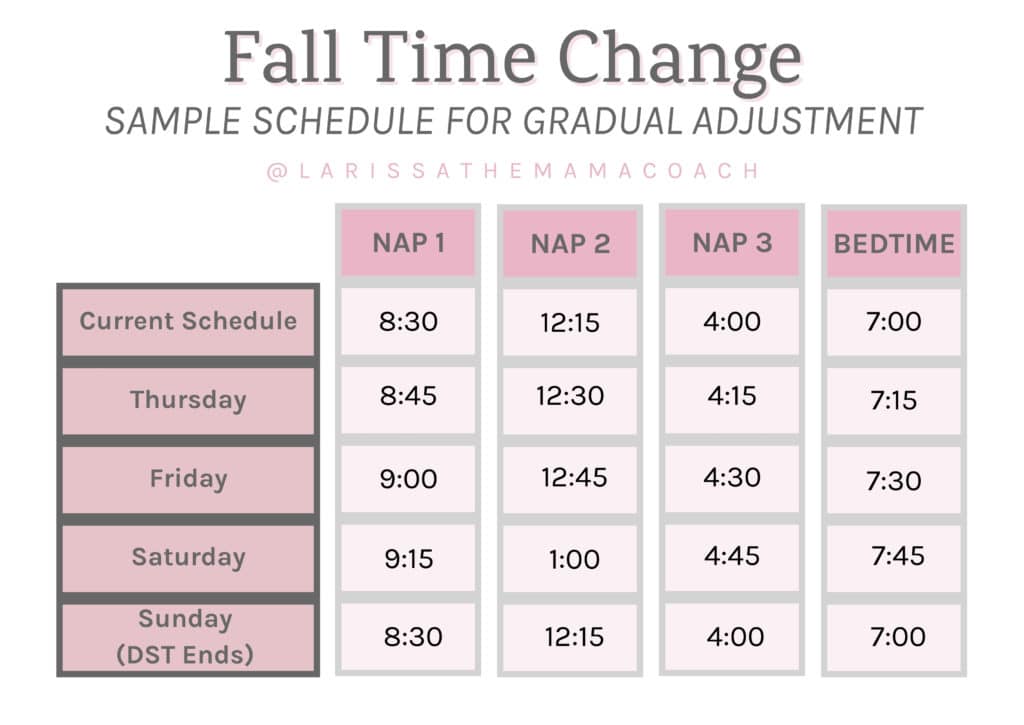It’s that time of year again, the dreaded fall time change — when the clocks fall back one hour, wreaking havoc on kids’ sleep schedules everywhere (well except in Arizona, where they don’t observe Daylight Saving Time — should we all move!?).

On Sunday November 5th, 2023 at 2am Eastern Time, Daylight Saving Time ends, and the clocks will turn back one hour to 1AM. This means that when your child goes to bed on Saturday night, if they wake up when the clock says 6am, it will feel like 7am to them. The typical challenge that arises after this time change is early morning wakes. Pass the coffee, please.
So what do we do!?
Don’t stress — you have options! I’ve outlined three different ways to deal with this time change below, and how to figure out which one is the best fit for your family.
1. Gradual Shift:
With this strategy, shift your baby’s sleep schedule later by about 15 minutes every day starting on the Thursday before the time change. When the clocks fall back on Sunday, your child’s sleep should match up with the “new” time. Here’s a chart that shows an example of how to do this:

This strategy is best for:
- Babies 3-8 months (taking 3 or more naps per day): These kiddos are more prone to becoming overtired. Pushing them to stay awake too long (by using the split the difference strategy below) may be too much for them to tolerate. Doing a gradual shift will allow their bodies to adjust more easily.
- Babies who are early risers: If your child is already waking up at 6am or earlier, a gradual method is likely best. It can be hard to push that wake time later, so doing so gradually will set you up for greater success.
- Parents who prefer a strict schedule: If sticking to your schedule is very important to you, a gradual approach will be the least disruptive and allow you to go by the new time as soon as the time change happens
2. Split the Difference:
The day before the time change (Saturday), push your child’s schedule later by a half hour. For example: if they normally go down for their first nap at 9am, try to stretch them until 9:30am and start their nap then. Same with the rest of their naps and their bedtime. If your child doesn’t nap, you’ll just put them down for bedtime 30 minutes later. On Sunday (the first day after the time change), go by the “new” time on the clock to determine your baby’s schedule and bedtime, which would mean pushing them another 30 minutes later than they’re used to. After Sunday, continue to go by the clock when determining their schedule. You may see some early mornings for a little while, but your child should adjust within a week.
This strategy is best for:
- Older babies (7+ months taking 2 naps or less a day) and toddlers: These kiddos aren’t as prone to becoming overtired and will likely tolerate an extra 20-30 minutes of awake time.
- Toddlers, Preschoolers, and School-Aged Kids who don’t nap: With older kids who’ve dropped their nap, the only thing you have to worry about pushing later is bedtime. If you use an okay to wake clock, be sure to adjust it the night of the time change to match the new time!
- Parents who prefer not to adjust in advance: If you’d rather not worry about moving your child’s schedule later for days before the time change, this is a great option for you!
3. Hands Off:
This one is easy! Don’t change anything with your child’s schedule, and once the time change happens, move their sleep times one hour earlier (it will feel the same as before the time change to them). If bedtime was at 7:30pm, it will now be 6:30pm (according to the new time). If they typically wake at 7:30am they will now wake at 6:30am. Your child will go to bed earlier and wake up earlier, but this works well for some families! You’ll either stay on this earlier schedule or your child’s schedule will naturally move later as time goes on.
This strategy is best for:
- Newborns: I recommend doing nothing to adjust your newborn for this time change! Newborns typically have late bedtimes, and sometimes it can be challenging to move bedtime earlier. In this case the time change is actually helpful!
- Babies, toddlers, or school-age kids who need to be woken up for daycare or school: By not adjusting their schedule you are giving them more time in the mornings to start their day! Instead of forcing them awake, their bodies will have time to naturally wake up which will decrease grogginess and should make for a happier morning. Be sure to move bedtime one hour earlier according to the new time (this will feel like their existing bedtime) so that they don’t lose any sleep.

What if the time change comes and goes and we are still struggling!? Here are some tips to help:
- If your baby wakes up too early, keep things calm and the lights low until the “normal” wake-up time. Try to hold off their feeding until then as well.
- During desired awake hours, expose your baby to sunlight, especially in the evenings. Light helps set our circadian rhythm!
- The sun will now be up earlier! If you don’t have blackout blinds, tape up black trash bags to keep out the early morning light.
- If your baby is struggling to make it to their next wake window, try these ideas for stretching awake time:
- Time in the carrier (carriers that allow for outward facing can be helpful so they don’t fall asleep!)
- Change up your baby’s scenery: head to a new room or go outside for some playtime
- Offer a snack if you’ve started solids to keep their energy up
- If your baby loves the bath, give them an extra long one to make it to the next sleep!
- If you have a toddler, use a toddler clock to help them learn to stay in their room even if they wake early. Explain to your toddler that when the clock turns green, that means GET UP AND GO! If the clock is off (or if you have it set to a sleep-friendly color like red or orange), that means it’s not time to get up yet. To help toddlers find the most success with these tools, temporarily try setting the clock to 15 minutes before their usual early wake time. That way when the child wakes, they will see the “wake up” color and get very excited – we want to celebrate their amazing achievement! Every few days, move the wake-up time ahead by 15 minutes until you’ve reached your ideal morning time.
- Breathe. Your child will eventually adjust! Kids usually get back on track by the one-week mark following a time change.









